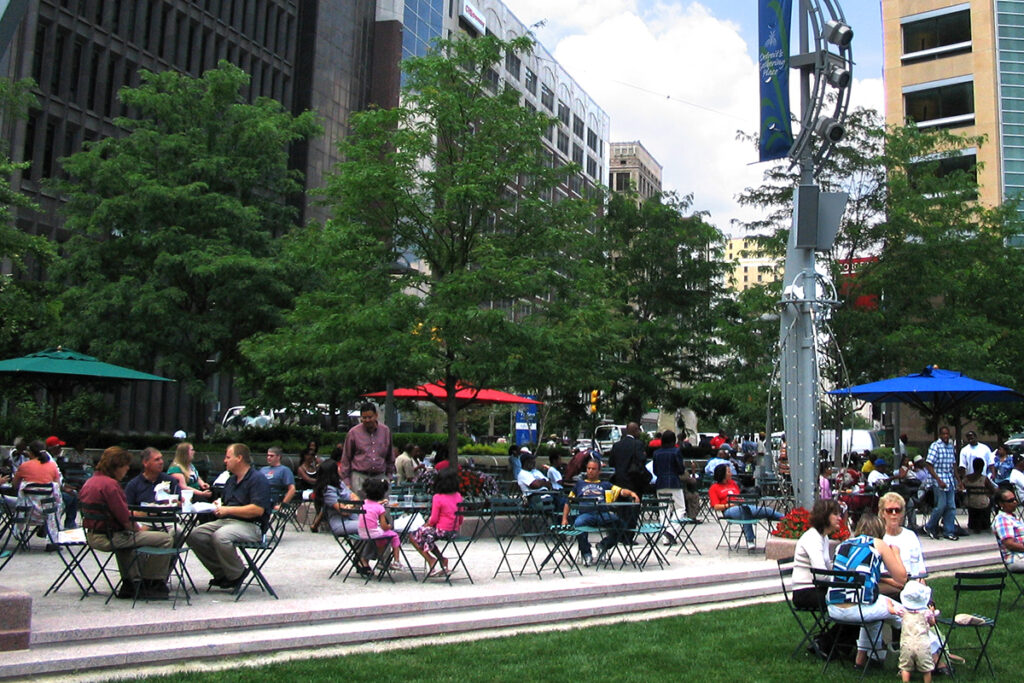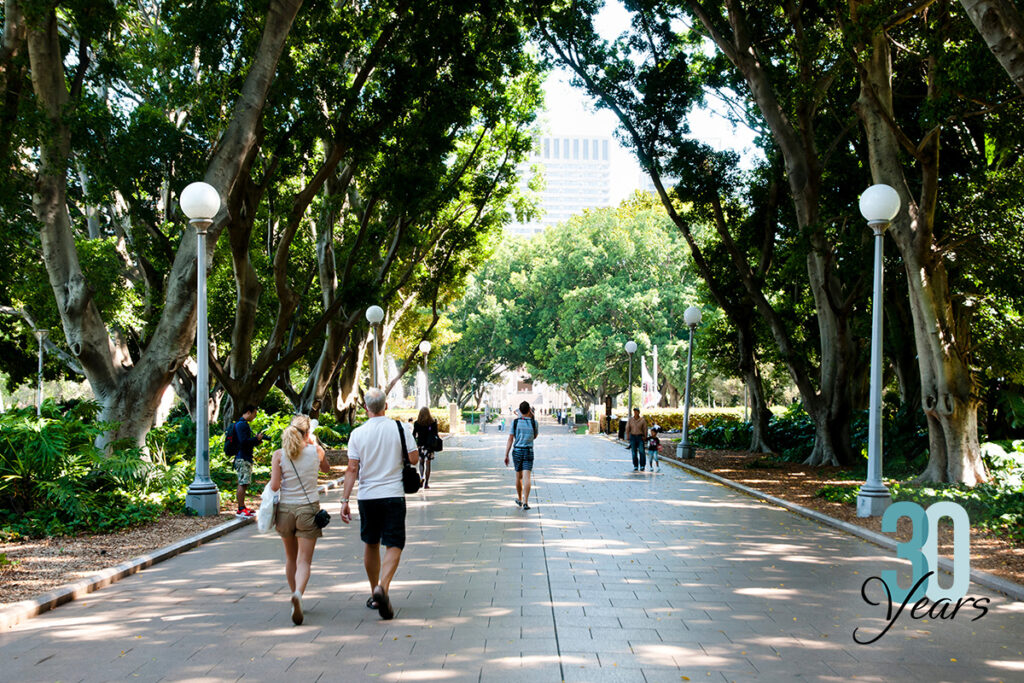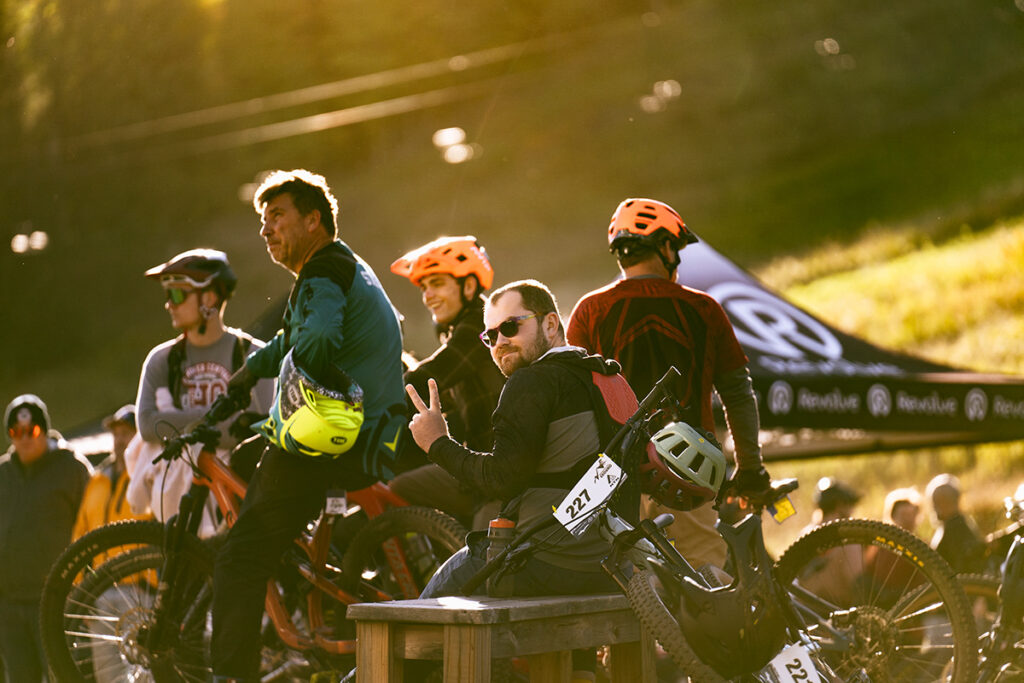Heat waves, coastal flooding, extreme precipitation events, and crop diseases threaten both urban and rural communities. These hazards carry economic consequences as well, from disrupted labor markets to strains on infrastructure essential for growth and competitiveness. At the same time, rapid technological change, including the adoption of generative AI, is reshaping the future of the workforce. While early research has attempted to quantify which occupations are most at risk, long-term impacts on employment remain uncertain. Together, climate and economic pressures highlight the need for resilience strategies that address both simultaneously.
Creating a strong sense of place not only establishes a distinct identity, it also helps people feel connected to their physical environment and to each other. Well-designed public spaces foster interaction across demographic and career cohorts, building the kind of social capital—the network of relationships across groups of people—that enables coordinated disaster response and mutual aid in times of crisis. In addition to making communities better equipped to handle and recover from disruption, these same networks strengthen the entrepreneurial ecosystem, while attractive and vibrant public spaces boost foot traffic to local businesses, support job growth and retention, and serve as a marketing asset. In this way, placemaking becomes a shared strategy for resilience. It provides the social infrastructure necessary for recovery from natural disasters while attracting increased spending and investment to guard against economic downturn.
TIP has applied these principles in recent engagements. In Texas, preparing small businesses for natural disasters emphasized the role of peer networks, mentorship, and shared spaces as critical tools for recovery. In Indian River County, Florida, TIP explored how to maintain a community’s high quality of life while diversifying its economy, using placemaking strategies to preserve identity, attract investment, and enhance local assets.
Texas Small Business Resilience
For small businesses across Texas, natural disasters pose a complex threat that extends far beyond physical damage. Owners often struggle with limited cash reserves, rising insurance costs, and complicated access to recovery programs like SBA loans. Even when resources exist, they can feel fragmented across agencies and organizations, leaving many entrepreneurs and small business owners unsure where to turn.
In 2024, the Federal Reserve Bank of Dallas engaged TIP to facilitate focus group sessions with small businesses and related organizations from across Texas, aimed at understanding how they perceive, prepare for, and respond to natural disasters. These conversations revealed that resilience depends as much on relationships and shared spaces as on financial tools.
Participants consistently pointed to peer networks as the most valuable source of information during crises. Owners who had endured hurricanes, floods, or prolonged power outages were viewed as trusted mentors, often more so than government agencies or formal disaster resource guides. This emphasis on lived experience created a powerful cycle of peer-to-peer learning, with businesses turning to one another for advice, reassurance, and practical solutions. In the absence of clear or consolidated guidance, these networks filled the gap, providing a trusted channel for communication and support.
The sessions also highlighted the role of intermediary organizations and shared physical spaces in sustaining resilience. Economic development groups, chambers of commerce, and business associations played a complementary role by convening networks, reducing the confusion of fragmented resources, and hosting educational events to prepare businesses for a range of hazards. Shared spaces such as co-working hubs, incubators, and chamber offices were recognized as critical community anchors. In times of crisis, these physical places can quickly shift from day-to-day business functions to recovery hubs. They provide internet access, distributing supplies, sharing updates, and enabling owners to maintain continuity.
Though the future of extreme weather events and natural disasters remains uncertain, the example of Texas small businesses illustrates that cities can equip their business communities for disaster preparedness and recovery by encouraging relationships between local businesses and organizations, strengthening the community’s social fabric and shared resources.
Indian River County, Florida
Located between Orlando and Miami, Indian River County, Florida, is familiar with the threat of extreme weather events. Natural Risk Index data published by FEMA and visualized by TIP illustrates that the county has a higher composite natural hazard risk than more than 97 percent of all US counties.
In addition to a high vulnerability to natural hazards, Indian River County has experienced an economic shift over the past decade. Its historically mighty citrus industry, once a strong source of local identity, has declined rapidly following the appearance of the disease known as citrus greening in the 2000s. As the disease is directly spread by the Asian citrus psyllid, shifting environmental conditions extend the range of warm, humid climates in which the insect thrives, contributing to the disease’s spread. In Indian River County, agriculture employment has since fallen nearly 60 percent (a loss of 1,600 jobs between 2001 and 2024), forcing the county to plan for a future beyond citrus.
Indian River County residents who participated in TIP-led input sessions noted that, when pursuing future growth and industry attraction, local development must be carefully managed to retain the county’s high quality of life and small-town character. TIP worked with Indian River County to develop strategies that fit the community’s assets, seeking ways to leverage existing employers, infrastructure, and local history.
Several real estate projects were identified as catalyst opportunities that could increase revenue for city and county services while cultivating the county’s sense of place. The strategic plan outlined strategies for supporting proposed revitalization of waterfront and vacant big-box properties, bringing enhanced retail, restaurants, lodging, and recreation amenities to the community. TIP also recommended elevating the county’s culture assets, from historic sites like Dodgertown—the Los Angeles Dodgers’ former spring training facility established during the Jackie Robinson era—to new attractions such as a planned surf park. Industry attraction strategies sought to further build on the county’s identity, including marketing Indian River County as an attractive destination for professional services workers and exploring agrotourism opportunities tied to its citrus production.
By working with community members to develop a plan that both reflects the cultural identity of Indian River County and allows for adaptation to shifting local economic priorities, TIP developed a plan that protects the county’s sense of place and positions it for resilience.
More Takeaways from Across the US
There are plentiful case studies from communities across the US that have strengthened their resilience through placemaking.
- Urban canopy expansions improve walkability, reduce heat and air pollution, and create healthier public spaces, while community gardens foster social connections, support food security, and encourage cultural exchange. The 19-acre Spaces of Opportunity in south Phoenix, Arizona, which serves as a community garden, incubator farm, and farmers market, provided tangible community benefits during the COVID-19 pandemic, distributing more than 43,000 pounds of produce to food-insecure families and food pantries.
- Placemaking can also serve as a catalyst for economic recovery. In 2004, the City of Detroit, Michigan, sought to reimagine its Campus Martius Park, utilizing simple amenities like outdoor seating, shade, and live music to transform the space into an informal community gathering place that enjoyed continued investment following the city’s bankruptcy in 2013. The park’s popularity has attracted major office tenants, over $2 billion in real estate investment, and an estimated 20,000 new jobs to its surrounding area since redevelopment began.
- Biddeford, Maine, a city just southwest of Portland, was once a hub of textile manufacturing. The non-profit Heart of Biddeford began redevelopment efforts in 2004 to beautify and convert vacant properties in the city’s historic mill district into residential and commercial space. By leveraging its architectural style, exemplified by properties like the mixed-use Lincoln Mill, Biddeford has cultivated a distinct sense of place. The city has enjoyed $216 million in downtown reinvestment, the addition of more than 160 new businesses, and recognition as a 2022 Great American Main Street Award winner.
Together, these examples underscore that placemaking is about more than aesthetic improvements. It is a core strategy for economic development and resilience. For practitioners, several lessons stand out:
- Tie placemaking to economic strategy. Public spaces, cultural landmarks, and redevelopment projects should be leveraged as assets that attract investment, support local businesses, and strengthen entrepreneurial ecosystems.
- Use placemaking as resilient infrastructure. Parks, community hubs, and shared spaces can double as anchors for disaster response, recovery, and social cohesion.
- Build on local identity. Tailoring placemaking to a community’s culture and history deepens connections, fosters pride, and provides a competitive advantage in uncertain economic and climate conditions.
By approaching placemaking with these principles, communities can safeguard quality of life while positioning themselves to face economic and climate uncertainties with flexibility and resilience.
Image credit: Campus Martius, Detroit, MI by jodelli via Flickr (CC BY 2.0)



